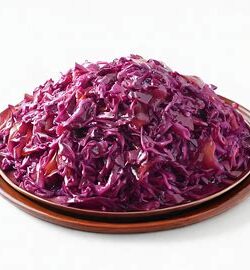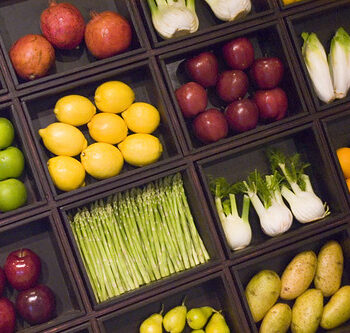German Red Cabbage with Cranberry Sauce is a Delicious Recipe
German red cabbage is a popular traditional dish in Germany, often served with meat dishes, especially roasts and game. It is known for its rich flavor and vibrant color. A delicious variation of this classic is German red cabbage with cranberry sauce. The sweet and tangy taste of cranberries perfectly complements the red cabbage, adding an extra layer of flavor.
Here is a simple recipe to prepare this tasty dish.
German Red Cabbage Ingredients:
- 1 medium-sized red cabbage head
- 2 onions
- 2 apples
- 2 tbsp butter
- 200 ml red wine
- 200 ml vegetable broth
- 3 tbsp apple cider vinegar
- 2 bay leaves
- 4 cloves
- 1 cinnamon stick
- Salt and pepper to taste
- 200 g cranberry sauce (store-bought or homemade)
Preparation:
- Thoroughly wash the red cabbage head and remove the core. Then, cut the red cabbage into fine strips. Peel the onions and slice them into rings. Peel the apples, remove the cores, and cut them into small cubes.
- In a large pot, melt the butter over medium heat. Add the onions and sauté until they become translucent. Then, add the red cabbage and apples to the pot and cook for a few minutes, stirring occasionally.
- Pour in the red wine and vegetable broth. Add the apple cider vinegar, bay leaves, cloves, and cinnamon stick. Season with salt and pepper according to your taste. Stir well to combine all the ingredients.
- Cover the pot with a lid and let the red cabbage simmer over low heat for about 45 minutes to an hour, or until it becomes tender. Stir occasionally to prevent it from sticking to the bottom of the pot.
- Once the red cabbage is cooked, remove the bay leaves, cloves, and cinnamon stick. Taste and adjust the seasoning if necessary.
- Serve hot, accompanied by a generous spoonful of cranberry sauce. The cranberry sauce adds a delightful touch of sweetness and tanginess to the dish, enhancing its flavors.
German culinary taste with cranberry sauce
German red cabbage with cranberry sauce recipe is a wonderful side dish that pairs well with various meat dishes, such as roasts, sausages, or even a festive holiday meal. It’s a fantastic way to incorporate the vibrant flavors of red cabbage and cranberry into your meals, adding a touch of German culinary tradition to your table. Enjoy!
HISTORY
The History of German Red Cabbage: A Traditional Side Dish with Deep Roots
German red cabbage, also known as Rotkohl or Blaukraut, is a classic side dish that has been a staple of German cuisine for centuries. This vibrant and flavorful dish is made from red cabbage, which is slowly braised with a combination of spices, vinegar, and sometimes apples or other fruits. Let’s explore the history of German red cabbage and its cultural significance.
Origins and Ancient Roots:
The cultivation of cabbage can be traced back thousands of years, with evidence of its consumption found in ancient civilizations such as the Egyptians, Greeks, and Romans. The red cabbage variety, with its distinct deep purple color, is believed to have originated in the Mediterranean region or parts of Asia.
Red cabbage, along with other cabbage varieties, made its way to Germany during the Roman Empire. The Romans introduced cabbage cultivation and consumption to many regions under their rule, including what is now modern-day Germany.
Medieval and Renaissance Period:
Red cabbage became an essential ingredient in German cuisine during the Middle Ages and the Renaissance. Cabbage, including red cabbage, was a hardy and reliable crop that could be grown in colder climates, making it particularly valuable during harsh winters.
During this period, preservation techniques such as fermentation and pickling became popular for preserving cabbage for long periods. Pickled red cabbage, known as sauerkraut, gained prominence and became a staple food in German households. Sauerkraut provided a vital source of nutrition during the winter months when fresh produce was scarce.
Development of Red Cabbage as a Side Dish:
Over time, red cabbage evolved from being solely used for sauerkraut to being prepared as a cooked side dish. The slow braising of red cabbage with aromatic ingredients became a popular method of preparation, enhancing its flavor and texture.
The addition of spices, such as cloves, juniper berries, and bay leaves, along with the use of vinegar or apple cider, added depth and complexity to the dish. Apples or other fruits were sometimes added to balance the acidity and provide a touch of sweetness.
Regional Variations:
As with many traditional dishes, German red cabbage has regional variations and adaptations. Each region may have its own preferred spices, flavor profiles, and cooking techniques. For example, in northern Germany, red cabbage is often cooked with apples, while in southern Germany, it is prepared with wine or vinegar.
Cultural Significance and Modern Popularity:
German red cabbage holds cultural significance in German cuisine and is commonly served as a side dish alongside hearty meals. It is a popular accompaniment to classic German dishes such as sausages, roast pork, and schnitzel. The vibrant colors of red cabbage also make it visually appealing, adding a touch of beauty to the plate.
In recent years, there has been a resurgence of interest in traditional and regional German cuisine, both within Germany and internationally. German red cabbage, with its rich history and unique flavors, has gained recognition as a flavorful and nutritious side dish.
Moreover, German red cabbage is appreciated for its health benefits. It is low in calories, high in fiber, and packed with vitamins and minerals. It is also rich in antioxidants, which contribute to its vibrant color and potential health-promoting properties.
In conclusion, the history of German red cabbage reflects its deep roots in German cuisine and its evolution as a beloved side dish. From its ancient origins to its prominent place in traditional and regional recipes, German red cabbage continues to be a flavorful and culturally significant part of German culinary heritage.

